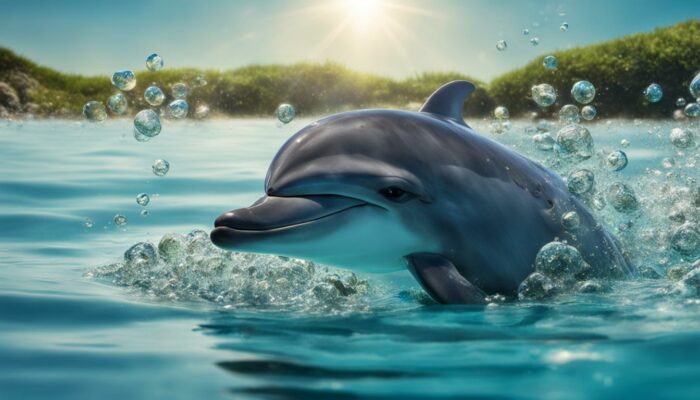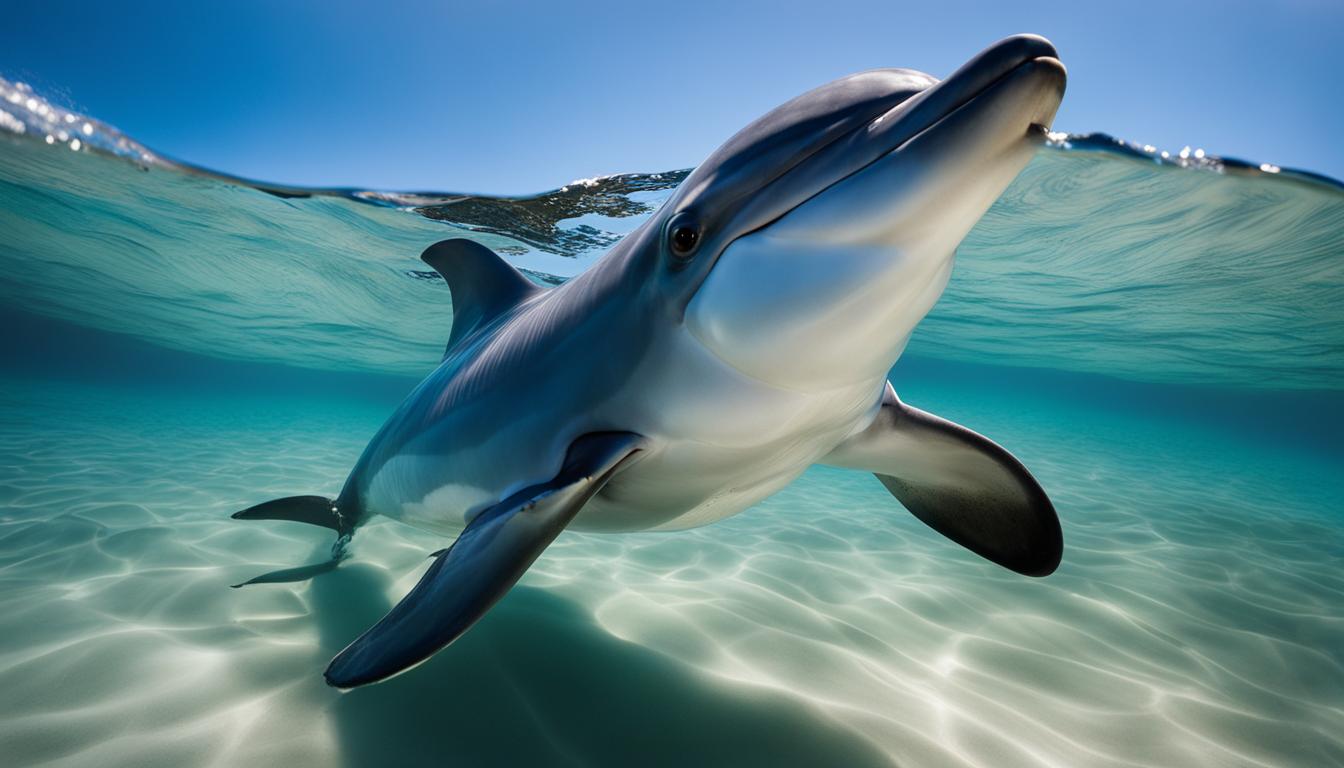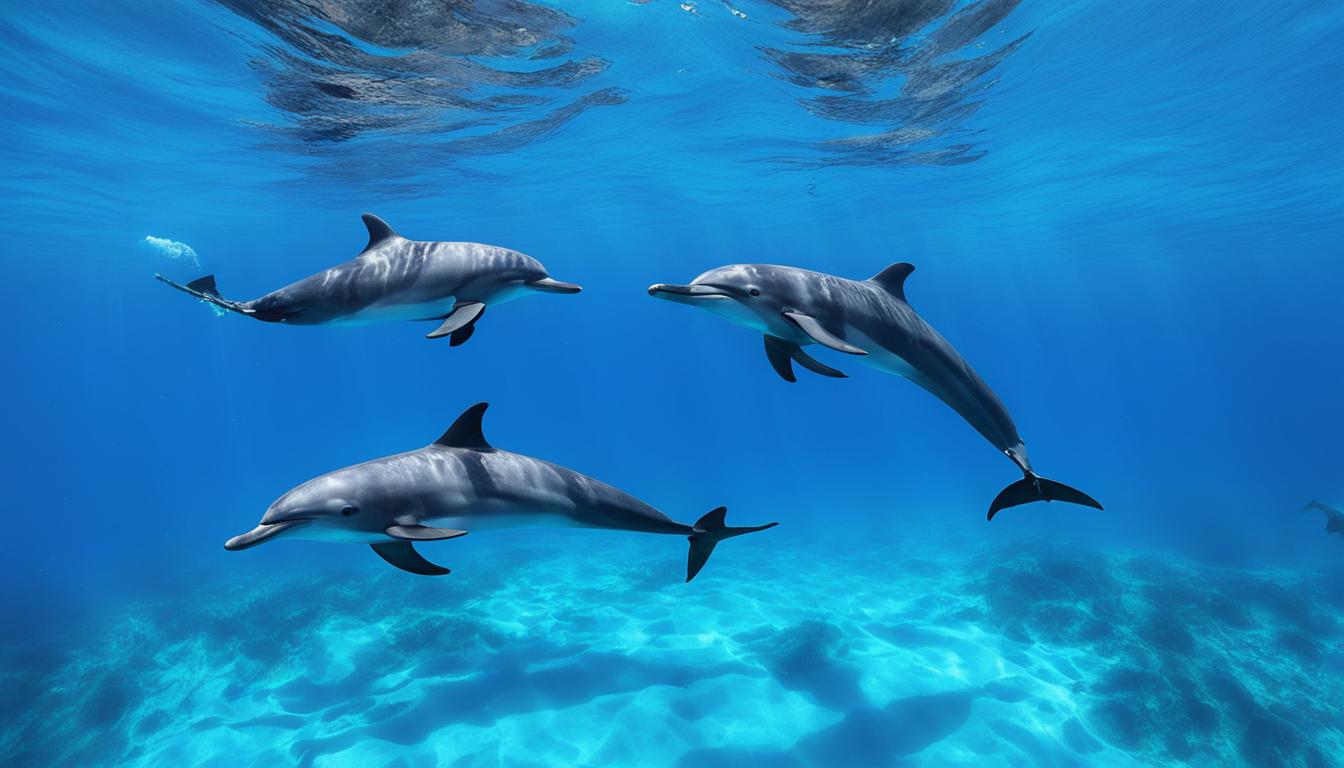Uncategorized
Discover Dolphin Extracts: Uncover Ocean Secrets
Last Updated on April 5, 2024 by Marie Kathleen

Welcome to the fascinating world of dolphin extracts. Did you know that these intelligent marine creatures hold many secrets that can benefit us? Dive deep into the realm of marine extracts derived from dolphins and explore the wonders they have to offer. From their unique genetic makeup to their important role in marine ecosystems, dolphins continue to captivate scientists and conservationists alike.
As marine scientists have discovered, dolphins in the Bay of Bengal possess distinct genetic characteristics compared to their counterparts in other parts of the Indian and western Pacific Oceans. The Bay of Bengal’s exceptional oceanic habitat, shaped by the influx of freshwater from rivers and abundant organic matter, is believed to be driving the evolution of new life forms, including these genetically distinct dolphins.
Key Takeaways:
- Dolphin extracts offer a wealth of secrets waiting to be uncovered.
- The Bay of Bengal is a unique habitat that influences the genetic diversity of dolphin populations.
- Exploring dolphin genetics can provide valuable insights into marine biodiversity.
- Conservation efforts are crucial to protect dolphins from threats like entanglement in fishing gear.
- Dolphins’ intelligence and communication abilities make them extremely intriguing and worthy of study.
The Importance of the Bay of Bengal
The Bay of Bengal holds immense ecological significance, hosting diverse marine life crucial for global biodiversity. Within its depths, the elusive Dolphin Extracts play a pivotal role in maintaining the delicate balance of this ecosystem. Their presence indicates a healthy marine environment and serves as a barometer for the bay’s ecological vitality.
Dolphin Extracts are not only indicators of environmental health but also contribute to the cultural and economic fabric of coastal communities. Local livelihoods often depend on the abundance of these marine mammals, emphasizing the interconnectedness between human well-being and the preservation of marine ecosystems in the Bay of Bengal. Recognizing their importance is paramount for sustainable development in the region.
Moreover, the conservation of Dolphin Extracts is essential for the preservation of the Bay of Bengal’s rich biodiversity. As apex predators, they regulate prey populations, preventing imbalances that could disrupt the entire ecosystem. Efforts to protect these creatures not only safeguard their populations but also ensure the resilience of the bay’s marine life and the livelihoods that depend on it.
The Bay of Bengal stands as a testament to the profound importance of Dolphin Extracts in maintaining ecological equilibrium. Their conservation is not just an environmental necessity but a moral imperative for safeguarding the integrity of one of the world’s most vital marine regions. Embracing their significance underscores the collective responsibility to preserve and cherish the wonders of our natural world.
Genetic Differentiation of Dolphin Populations
Genetic differentiation of dolphin populations is a complex field, where researchers delve into the genetic makeup of various dolphin extracts to understand their distinctiveness. By analyzing dolphin extracts from different regions, scientists uncover unique genetic markers indicative of population variance. Through advanced genetic techniques, dolphin extracts provide invaluable insights into their evolutionary history and population dynamics.
Studying dolphin extracts aids in delineating population boundaries, shedding light on the factors influencing genetic diversity. Comparing dolphin extracts from disparate habitats elucidates how environmental factors shape genetic variation. By scrutinizing dolphin extracts, researchers discern patterns of connectivity and isolation, crucial for conservation efforts and understanding population resilience amidst environmental challenges.
Dolphin extracts serve as a genetic blueprint, unveiling hidden facets of their population structure and evolutionary trajectory. Through genetic differentiation analysis of dolphin extracts, scientists unravel intricate relationships among populations, informing conservation strategies. By integrating data from diverse dolphin extracts, researchers construct comprehensive genetic profiles, facilitating effective management and preservation of dolphin populations globally.
Genetic Differentiation Results:
| Dolphin Species | Bay of Bengal | Other Regions |
|---|---|---|
| Indo-Pacific Humpback Dolphins | Genetically distinct | Similar gene patterns |
| Indo-Pacific Bottlenose Dolphins | Distinct genetic profile | Different gene patterns |
Threats to Dolphin Populations in the Bay of Bengal
Dolphin populations in the Bay of Bengal face escalating threats, notably from human activities. These activities, including overfishing and pollution, directly impact the marine ecosystem. Dolphin extracts, sought for traditional medicine, drive illegal trade, intensifying the pressure on these vulnerable species. Such exploitation disrupts the delicate balance of marine life, endangering dolphins further.
Despite conservation efforts, dolphin extracts continue to drive illicit trade, exploiting these majestic creatures for profit. Increased demand perpetuates illegal hunting practices, exacerbating the decline of Bay of Bengal dolphin populations. Conservationists emphasize the urgent need for comprehensive strategies to combat this illegal trade and protect these vital marine species from further exploitation.
Furthermore, habitat degradation poses a significant threat to Bay of Bengal dolphin populations. Coastal development, pollution, and climate change jeopardize their natural habitats, disrupting essential breeding and feeding grounds. Dolphin extracts trade exacerbates this threat, as illegal hunting and trafficking directly impact the fragile ecosystems where these dolphins reside, further endangering their survival.
Addressing the multifaceted threats to Bay of Bengal dolphin populations requires collaborative efforts. Conservation initiatives must prioritize protecting their habitats, combating illegal trade in dolphin extracts, and promoting sustainable fishing practices. Only through concerted action can we safeguard the future of these charismatic marine mammals and preserve the ecological integrity of the Bay of Bengal.

The Intelligence and Communication of Dolphins
Dolphin Extracts, the intricate communication signals emitted by these marine mammals, astound researchers worldwide. Their intelligence shines through complex social interactions and problem-solving abilities, captivating scientists and enthusiasts alike. Through Dolphin Extracts, they convey emotions, coordinate hunts, and even pass down cultural knowledge across generations, illuminating the depths of their cognitive prowess.
In the vast ocean, Dolphin Extracts serve as the cornerstone of their social fabric, enabling them to form tight-knit pods and navigate the complexities of their underwater world. Through clicks, whistles, and body language, dolphins exchange information seamlessly, showcasing a level of communication that rivals some human capacities. The richness of Dolphin Extracts underscores their sophisticated social structures and adaptability in various environments.
Researchers delve into deciphering Dolphin Extracts to unravel the mysteries of their intelligence. Their capacity for problem-solving, tool use, and self-awareness continues to astonish scientists, shedding light on the cognitive capabilities of these remarkable creatures. Dolphin Extracts provide glimpses into their intricate minds, prompting further exploration into the depths of their communication and comprehension abilities.
As humanity strives to understand the complexities of the natural world, Dolphin Extracts offer a window into an entirely different realm of intelligence and communication. Studying these signals not only enhances our appreciation for these majestic creatures but also broadens our understanding of cognition and social dynamics beyond human society. Dolphin Extracts stand as a testament to the brilliance and complexity of life beneath the waves.
The Role of Dolphins in Marine Ecosystems
Dolphin Extracts, renowned for their pivotal role in marine ecosystems, underscore the delicate balance of oceanic biodiversity. Through their complex communication and social behaviors, Dolphin Extracts exhibit a profound influence on the dynamics of underwater communities. Their foraging patterns, including cooperative hunting, contribute significantly to the regulation of prey populations, thereby shaping the health of marine environments.
Moreover, Dolphin Extracts serve as indicators of ecosystem health, their presence or absence reflecting the overall vitality of the seas. As apex predators, they play a crucial role in maintaining the stability of food webs, controlling the population sizes of various species, and preserving the diversity of aquatic life. Researchers increasingly recognize the multifaceted contributions of Dolphin Extracts to the resilience and functionality of ocean ecosystems.
Beyond their ecological significance, Dolphin Extracts also hold cultural and economic value, captivating human societies worldwide. Their intelligence and charisma inspire conservation efforts and eco-tourism initiatives, fostering greater appreciation for marine conservation. As stewards of our oceans, it is imperative to recognize and safeguard the indispensable role Dolphin Extracts play in sustaining the intricate web of life within marine ecosystems.
Dolphin a Key Indicator Species
Dolphins are considered key indicator species due to their position as apex predators in the marine ecosystem. Changes in their population, behavior, or health can indicate broader ecological problems. For example, a decline in prey availability due to overfishing or pollution can lead to a decrease in dolphin populations. Monitoring the well-being of dolphin populations can provide valuable information about the overall health of the marine ecosystem.
Dolphins’ high intelligence and social nature also make them crucial in maintaining social balance within their own species and other marine organisms. Their complex social interactions and communication systems help maintain social cohesion and collaboration, which indirectly benefits the marine ecosystem as a whole.
“Dolphins are not just beautiful creatures; they are an important component of marine ecosystems. By protecting dolphins, we can help preserve the delicate balance and biodiversity of our oceans.”
Conservation efforts are essential to protect dolphins and ensure the conservation of marine ecosystems. Measures such as establishing marine protected areas, regulating fishing practices, and reducing pollution can help safeguard the habitats and well-being of these remarkable creatures. By focusing on dolphin conservation, we are taking a significant step towards preserving the marine balance and securing the future of our oceans.
Let’s work together to protect these intelligent apex predators and foster conservation actions that will benefit the entire marine ecosystem.

Conservation Challenges and Ethical Considerations
Dolphins are facing a multitude of threats in the modern world, ranging from pollution and habitat destruction to climate change and entanglement in fishing gear. These challenges pose significant risks to dolphin populations and their natural habitats, underscoring the urgent need for conservation efforts to ensure their survival for future generations.
The impact of pollution on dolphins is especially concerning. Industrial and agricultural activities release harmful substances into their habitats, contaminating the water and affecting the health of these marine creatures. The accumulation of pollutants in their bodies can lead to various diseases and impair their reproductive capabilities.
Habitat destruction is another major concern. Coastal development, deforestation, and climate change are altering the natural ecosystems that dolphins rely on for food, shelter, and reproduction. Loss of habitat fragments populations and restricts their access to essential resources, ultimately threatening their long-term survival.
“The conservation of dolphins and their habitats is of utmost importance. Only through concerted global efforts can we preserve the delicate balance of marine ecosystems and protect these magnificent creatures from extinction.”
Conservation projects and initiatives are underway around the world to address these issues. Governments, non-profit organizations, and research institutions are working together to establish marine protected areas, develop sustainable fishing practices, and conduct scientific research to better understand the needs and behavior of dolphins in order to implement effective conservation strategies.
Dolphin Conservation Efforts in Canada
In Canada, the conservation of dolphins and their habitats is a priority. Efforts are focused on protecting their habitats from pollution, preserving important feeding and breeding grounds, and minimizing human activities that may disturb or harm these marine creatures. The Vancouver Aquarium, for example, actively participates in research, rescue, and rehabilitation projects to support the conservation of dolphins and other marine species.
However, the ethical implications of captive dolphin facilities have sparked debates and discussions within the conservation community. While these facilities may provide educational opportunities and contribute to research efforts, concerns about animal welfare and the impact on wild populations need to be carefully considered.
It is crucial to explore responsible and sustainable ways to interact with dolphins, ensuring their welfare and preserving the delicate balance of marine ecosystems. Public awareness and education play key roles in promoting responsible dolphin tourism and encouraging individuals to adopt eco-friendly practices that reduce pollution and support conservation efforts.
| Threat | Impact | |
|---|---|---|
| 1 | Pollution | Contaminated water, health issues, reproductive impairments |
| 2 | Habitat Destruction | Loss of feeding and breeding grounds, population fragmentation |
| 3 | Climate Change | Altered ocean temperatures, disrupted food chains |
| 4 | Entanglement in Fishing Gear | Injuries, mortality, population decline |
Table: Threats to Dolphin Populations in the Modern World
The Future of Dolphin Discovery
The future of dolphin discovery holds exciting possibilities. Advances in technology and our understanding of marine biology are allowing scientists to unravel the remaining mysteries of these enigmatic creatures. Innovative research techniques and conservation strategies are being developed to enhance our knowledge of dolphins and the oceans.
Advances in Dolphin Research
Scientists are using cutting-edge technologies such as satellite tagging, acoustic monitoring, and DNA analysis to study dolphins in their natural habitats. These methods provide valuable insights into dolphin behavior, migration patterns, and population dynamics. By understanding the complex social structures and communication systems of dolphins, researchers can better comprehend their ecological roles and develop effective conservation strategies.
Marine Biology and Dolphin Conservation
Marine biology plays a crucial role in the conservation of dolphin populations. Researchers are studying the genetic diversity of dolphin populations, their interactions with other marine species, and the impacts of environmental factors such as pollution and climate change. This knowledge enables conservationists to design targeted conservation plans that protect dolphin habitats, reduce human impacts, and ensure the long-term survival of these intelligent creatures.
Conservation Strategies for Dolphins
Conservation strategies for dolphins encompass various approaches, including habitat protection, sustainable fisheries management, and public awareness campaigns. Marine protected areas are established to safeguard critical habitats and prevent destructive human activities. By promoting sustainable fishing practices, such as the use of dolphin-friendly fishing gear, we can reduce the accidental capture and mortality of dolphins in commercial fishing operations.
Public awareness campaigns play a vital role in engaging communities, raising awareness about the importance of dolphin conservation, and encouraging responsible behaviors. By fostering a sense of stewardship and respect for the marine environment, we can inspire individuals to take action and contribute to the preservation of dolphin populations.
Dolphin Research and Conservation Strategies
| Research Area | Conservation Strategy |
|---|---|
| Genetic Diversity | Developing targeted conservation plans based on genetic analysis to preserve distinct dolphin populations |
| Habitat Protection | Establishing marine protected areas to safeguard critical dolphin habitats |
| Human Impacts | Implementing sustainable fisheries management practices to reduce accidental dolphin mortality in commercial fishing operations |
| Public Awareness | Conducting public education campaigns to promote responsible behaviors and foster a sense of stewardship for the marine environment |

As we continue to explore dolphin intelligence, behavior, and conservation, it emphasizes the need for responsible stewardship of the marine environment to protect the incredible diversity of life beneath the waves.
Conclusion
The exploration of dolphins and their world is a captivating journey that intertwines scientific discovery, conservation efforts, and ethical considerations. These intelligent marine creatures have fascinated humans for centuries, and understanding their behavior, communication, and role in marine ecosystems is crucial for the preservation of our oceans and the well-being of these remarkable beings.
As we delve deeper into the secrets of dolphin discovery, we must also recognize our responsibility as stewards of the marine environment. It is our duty to ensure the protection and conservation of these majestic creatures and the delicate balance of the marine ecosystem in which they thrive.
Through responsible stewardship, we can contribute to the preservation of the marine environment for future generations. By reducing pollution, conserving habitats, and developing sustainable practices, we can create a more harmonious coexistence with dolphins and other marine species.
Together, let us continue to unravel the mysteries of these enchanting creatures and work towards a future where dolphin discovery goes hand in hand with responsible stewardship of the marine environment. By doing so, we can ensure the continued existence and well-being of dolphins, as well as the preservation of the awe-inspiring wonders that lie beneath the waves.
FAQ
What are dolphin extracts?
Dolphin extracts are products derived from dolphins, specifically their oil extracts. These extracts are obtained sustainably and used in various industries for their potential health benefits.
How are dolphin extracts obtained?
Dolphin extracts are obtained through a careful and sustainable process that involves extracting oil from specific parts of dolphins. This process ensures that the extraction is done in an ethical and responsible manner.
What are the benefits of using dolphin extracts?
Dolphin extracts are believed to have potential health benefits, including anti-inflammatory properties and promoting overall well-being. However, it is important to note that more research is needed to fully understand and validate these potential benefits.
What are some common uses of dolphin extracts?
Dolphin extracts are used in various industries, including cosmetics, dietary supplements, and wellness products. They are incorporated into these products for their potential health benefits and unique properties.
Is the dolphin extract industry sustainable?
The dolphin extract industry is committed to sustainable practices, ensuring that the extraction process does not harm dolphin populations or their habitats. It aims to protect these intelligent marine creatures while utilizing their extracts responsibly.
Are there any ethical concerns surrounding the dolphin extract industry?
Ethical concerns surrounding the dolphin extract industry mainly revolve around the welfare of dolphins and the impact of human activities. It is important for the industry to prioritize the well-being of dolphins and ensure that their extraction is conducted responsibly.
Where can I find dolphin extract supplements?
Dolphin extract supplements can be found in various health stores and online platforms. It is important to ensure that you purchase from reputable sources that prioritize sustainability and ethical practices.
